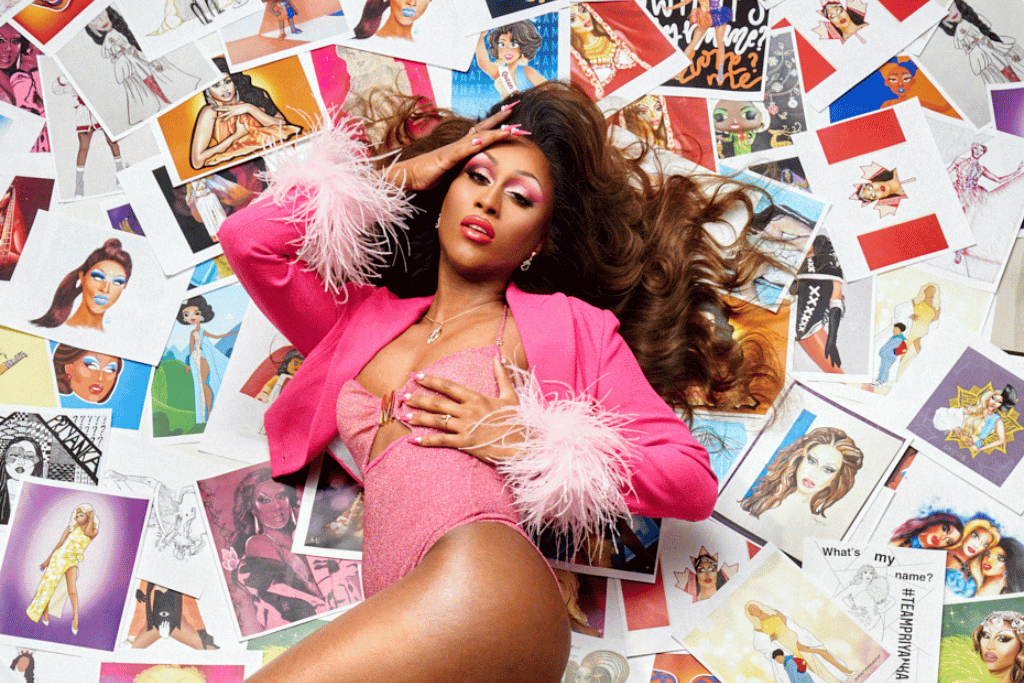As any disciple of RuPaul’s Drag Race will tell you, nothing is ever guaranteed. RuPaul, the entertainment scion and drag queen widely credited for ushering drag culture into the mainstream, likes to keep her queens on their toes. The show, which is now in its 13th season and has launched a growing list of international franchises, is the ultimate test of a drag queen’s performance abilities. It is a gauntlet that ultimately crowns an individual each season for having the most—as RuPaul puts it—“Charisma, Uniqueness, Nerve, and Talent.” Sometimes, the most experienced queens end up leaving early while others remain longer than anyone would have predicted. But when Priyanka was crowned the winner of the first season of Canada’s Drag Race, it wasn’t really a surprise.
No shade to the queens that Priyanka, nee Mark Suknanan, vanquished on her rise to the top; they were all incredible entertainers and artists in their own right. But throughout the season, you could see that Priyanka was unique. She worked at a different level and became a star presence on the show, endearing herself to an audience spellbound by her quick wit and identifiable humour—her energy and attitude was both winning and contagious. Because of her background in media (before drag, she cut her teeth in the industry as a YTV host), Priyanka instinctively knows what makes good television. And so every moment, she’s utilizing her experience and working different angles simultaneously: she’s focused on winning the challenge at hand, constantly reinforcing her personal brand, and making sure the show is as entertaining as possible. It was as if her run was just a prologue to a career-ready to blast off, and she was killing it.
The only thing that might be surprising are the brands lining up to work with a drag queen, like BMO and SodaStream—corporate giants looking to harness the power of drag culture. Though chances are, if this is news to you, you’ve been sleeping under a rock. Because drag culture is pop culture (and ultimately, business culture).
“RuPaul’s Drag Race being on Netflix and Crave, and then VH1 and all these mainstream networks means the average Joe out of Ajax, Ontario was now seeing Drag Race,” Priyanka says. There was a time, she notes, when drag bars were almost exclusively patronized by members of the LGBTQ+ community. But that all changed once technology catalyzed access to the show. “Once Drag Race started, [there were] suburban moms and bachelorette parties, and although we were all like, ‘Don’t come into our spaces!’—what it was actually saying was that drag is becoming more mainstream than we think it is.”
Drag existed long before Drag Race and has always played a significant role in the LGBTQ+ community. Its unapologetic challenging of gender norms has always been a subversive commentary of culture and politics, influencing it from the fringes. And make no mistake, its influence is major. Watching the classic documentary Paris is Burning about the legendary drag balls of the 80s is basically watching the birth of Madonna, Lady Gaga, and half of the pop culture vernacular we use every day. RuPaul’s Drag Race, which began in 2009 and has won 19 Emmy Awards (and 39 nominations), just catapulted drag right into the mainstream spotlight.
Let academics and pop culture critics discuss why the world is ready for drag now; the important thing is that drag, as an artform and industry, is ready. While athletes, actors, and musicians have leveraged their names and fame for business ends since forever, there is perhaps no other subculture that is as entrepreneurial as drag, given its roots. It’s all about building a personal brand and getting that brand noticed, cultivating an audience and keeping them engaged through social media, merch, and performance art.
“Before I was on Drag Race, I had a very business-oriented mind. I had my taglines, I already had merch,” Priyanka says. “I always kept in mind a brand and a marketing strategy in my drag. The first thing I said when I made my entrance on Canada’s Drag Race was ‘What’s my name?’ That’s my tagline, so it starts before you get the platform. You need to build it and brew it and test it out before you go to the big leagues like Drag Race.”
The name, tagline, and merch are all essential building blocks to establishing a relationship with your audience. After all, drag, like any industry or business, is competitive—anything that helps a performer stand out and be remembered is an edge.
“There’s something cool about entrepreneurship, it’s all DIY,” Priyanka explains. “Now with a show like Drag Race, we’re able to turn ourselves into a business.” Indeed, many of the traits that are often associated with entrepreneurship (resourcefulness, resilience, agility) are ones that drag queens must learn to master. “Being on Drag Race each week, you have a look on the runway and you make sure that those photos go out every single week,” she says. “Then you have merch that people buy, and then you have something you might say that goes viral online. So you have to turn that into merch, too. Then you want to create music with your taglines in it. You truly become your own business. You are selling yourself to people who just love you.”
Of course, all the branding and merchandising wouldn’t get people to remember Priyanka if she didn’t have a defined point of view. It’s another business lesson taken from drag. It’s like how RuPaul ends every episode: “If you can’t love yourself, how the hell you gonna love somebody else?” And to love yourself is to be on a journey of self-discovery. Priyanka stood out on the show by sharing her cultural heritage, and opened up about how that culture affects her relationships—about how, for example, she could be on a national television show about drag performance and still not be out to her father.
“A lot of my success from Drag Race came from me being able to just unapologetically open up about my past,” she says. “I want people to feel like they’re escaping while they watch me perform. That’s my point of view. I always say that if you want to do drag for attention, you’re doing it for the wrong reasons.”
It’s a lot of work for some attention. Setting aside the sheer amount of labour that goes into transforming into their drag personas—the wigs, the pads, the makeup (oh, the makeup!), the tucking—the modern drag queen has to do so much more if they want others to say their name. And that’s especially true during a global pandemic.
“It’s important to dip your toes in everything. It used to be that you had to be good at doing your own wigs and knowing how to make your own costumes,” she says. “But now you have to be good at shooting your own music videos, knowing how to edit, how to use Twitch, how to livestream on Instagram, and how to set up Zoom calls. It’s completely transformed to becoming more digital, because if you are more digital, then you’ll appeal to more people, which will then make for a better business.” Drag queens, like everybody else, have had to adapt not only with the pandemic, but also with the times. And that has meant diversifying their skill sets to best match the needs of their audience.
It’s one of the reasons drag queens make such savvy business people. Priyanka seems to understand marketing organically. It’s a bit ironic, given the makeup, the alias, and the costumes, but drag queens understand the power of authenticity better than most. They understand that there’s a difference between being known and being understood. The best drag queens are simultaneously larger-than-life avatars of gender performance and entirely themselves. One of the ways that Priyanka maintains that balance is by using social media to show both of her sides.
“When you see a queen in live performance spaces, they’re done up. The wig is on, the lashes are on. They’re performing a song. It’s top to bottom perfection,” she says. “When you see a queen online, there’s this vulnerability. That is the reason why people love Drag Race, because they see the vulnerable side of the queen and they fall in love with her. It’s important for entertainers to use social media as the behind-the-scenes to the drag, because that’s what will lock your audience.”
And once they are locked, they’ll support and follow you, which is what brands are looking for. Perhaps the connection between drag and banking isn’t immediately apparent (though, with all their natural business acumen, the connection isn’t exactly tenuous.) But even if it’s not, we celebrate the ad campaign because we love Priyanka. Of course, one still has to pick their business partners wisely—drag and commerce go well together, but no one likes a sell-out. For queens like Priyanka, that’s easier to do when you know what you bring to the table.
“I think that for any drag queen that wants to be a big business, they have to know what their niche is and drive it into the ground,” she says. “Every successful drag queen has something super unique about them that you can’t go to the store and just pick out.”
Drag queens may be seen as the height of entertainment right now but they’re also the savviest entrepreneurs in the game. This isn’t anything new. Drag queens have always been resilient, resourceful, and quick to adapt—society is just catching up and finally appreciating them for the artists and marketing geniuses that they are. Whether you’re an entrepreneur, small business owner, corporate giant, or self-employed, we can all learn a thing or two about building a business from drag queens.
Even before Drag Race Canada, Priyanka was busy laying down the bricks of her inevitable business empire. And it’s because of the time and years she’s put in that, when people see her now, they know her name.
Photography by Colin Gaudet; fashion direction by Amber Watkins and Jenna Aranas (assistant); hair by Kirsten Klontz/P1M (using Hot Tools Professional); makeup by Caroline Levin/P1M; nails by Pinky’s.








